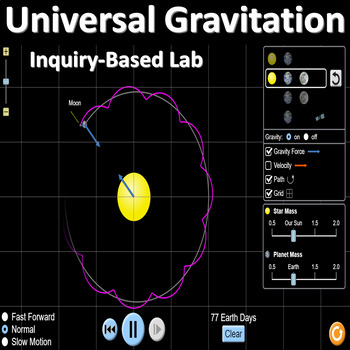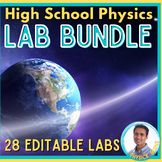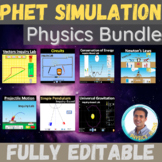Universal Gravitation and Orbits Inquiry Lab (Phet Simulation) | Physics
- Zip
- Google Apps™

What educators are saying
Also included in
- Full High School Physics Lab Curriculum. Every lab is editable, so you can tweak things to fit your classroom perfectly. Each of these labs requires only basic materials.Here are all the labs that I do with my Regular, Honors, and AP Students. Each lab comes with worksheets that are differentiated dPrice $99.99Original Price $145.67Save $45.68
- These are 10 simple inquiry-based labs that I love to give students as an intro to different physics chapters. Students will figure out for themselves conceptual problems in different chapters. They will get the basic idea of the physical laws of each chapter while discovering mind-blowing conceptsPrice $29.99Original Price $39.62Save $9.63
- Here are my THREE favorite labs for Uniform Circular Motion (UCM) and Universal Gravitation (UG). Each of these labs leaves my students excited to learn physics through making experiments, discussing, and moving their bodies. Every year these are the labs I provide to my students who often tell me tPrice $10.99Original Price $13.85Save $2.86
Description
This is a simple inquiry-based lab that I love to give students as an intro to Universal Gravitation. Students will figure out for themselves conceptual problems involving Universal Gravitation. They will get the basic idea of how Universal Gravitation works while discovering mind-blowing concepts, such as how the mass affects the gravitational pull on different objects. Lastly, the last page of the lab also includes calculations for students who have been introduced to the math portion of Universal Gravitation. Everything is fully editable.
Students will:
- Learn through play
- Have guided questions to direct learning
- Discuss and Hypothesize
- Come up with Conclusions
- Be a part of real-world applications for Universal Gravitation
______________________________________________________________________________________________
Save over 20% and Buy The Phet Bundle
Phet Lab Bundle
Lesson Plan Bundle
Uniform Circular Motion Lesson Plan Bundle
________________________________________________________________________________________
Check out my Youtube Channel, Facebook Group, and Follow my Store :)
If this product could really benefit your classroom, but you are not in a good financial situation to buy the product, please contact me and I will give you the product for free, no questions asked. Raymondburnseducator@gmail.com





